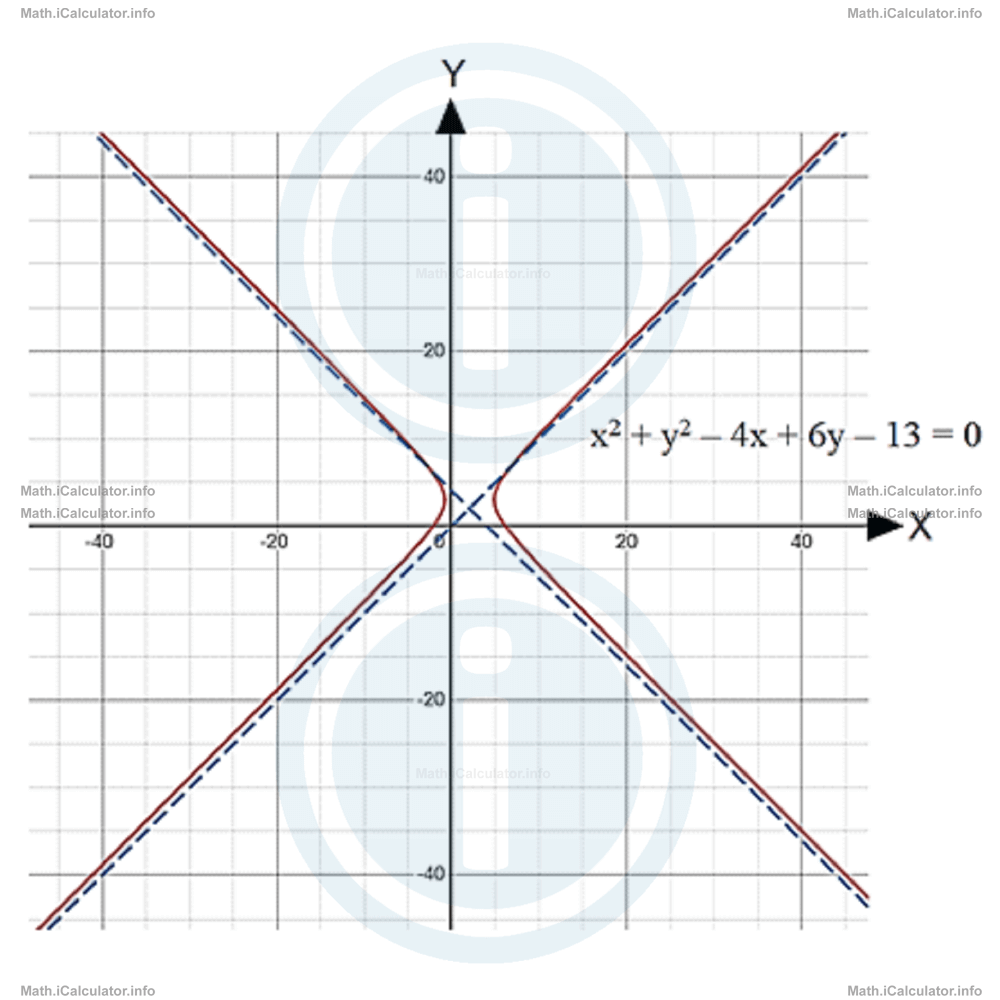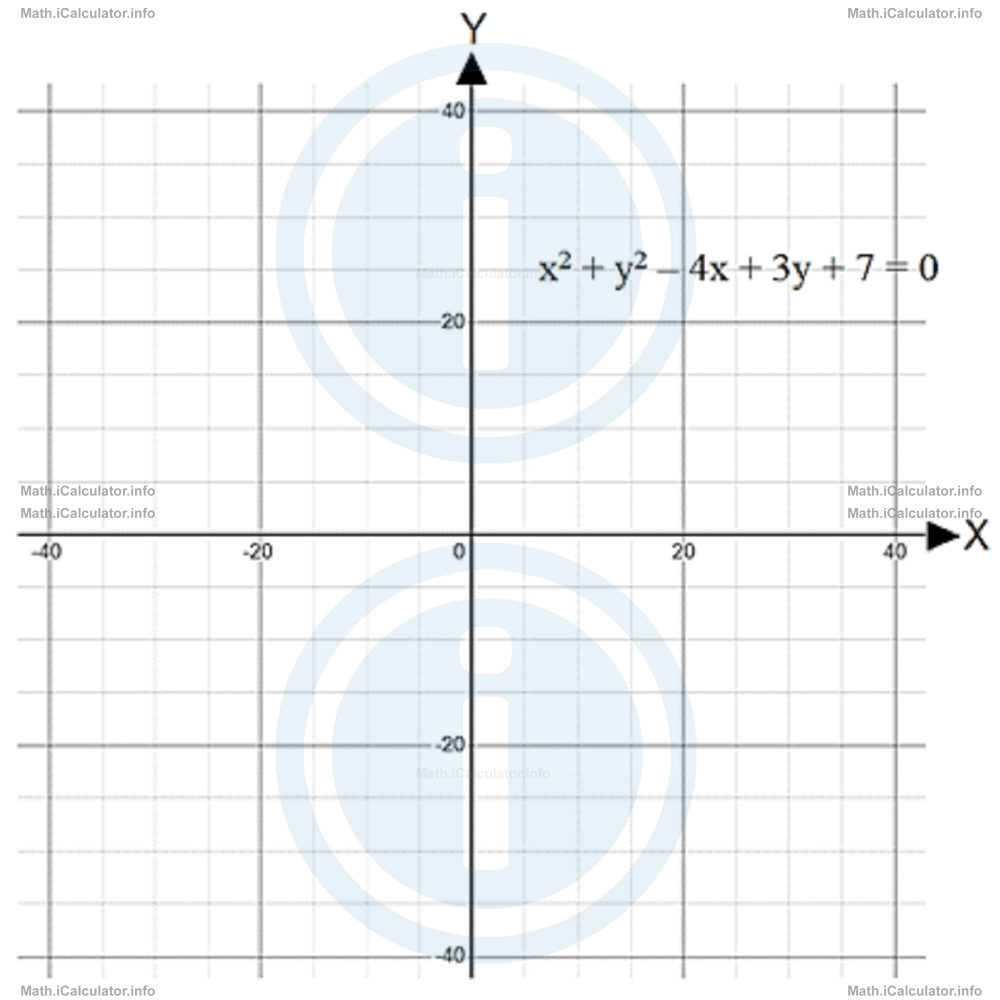Menu
Math Lesson 15.6.3 - Equation of a Circle when it is expressed as a Polynomial
Please provide a rating, it takes seconds and helps us to keep this resource free for all to use
Welcome to our Math lesson on Equation of a Circle when it is expressed as a Polynomial, this is the third lesson of our suite of math lessons covering the topic of Circle Graphs, you can find links to the other lessons within this tutorial and access additional Math learning resources below this lesson.
Equation of a Circle when it is expressed as a Polynomial
Sometimes, the equation of a circle is expressed as a polynomial in the expanded form
where a, b, c and d are coefficients while e is a constant.
For example,
shows a circle though at a first glance it looks like a second-degree polynomial with two variables (in fact, it is so, but geometrically it represents a circle).
Obviously, in circles the two coefficients a and b must be equal; otherwise, there is no symmetry around the centre C. In all examples considered so far, we have a = b = 1. If the value of these two coefficients is different from 1, then we multiply all terms of the corresponding polynomial by 1/a (or 1/b if you wish) in order to write it in the simplest form with a = b = 1.
For example, we can divide by 2 all terms of the circle 2x2 + 2y2 + 8x - 4x - 14 = 0 to obtain the equation
which is equivalent to the original one but expressed in the simplest form.
Actually, not all the second-degree polynomials with two variables represent circles in the coordinates system. For example, the graph of the second-degree polynomial with two variables
shows a pair of hyperbolas like the ones we have seen in the reciprocal graphs, buts rotated in such a way that asymptotes are neither horizontal nor vertical but something in-between, as shown in the graph below.

In other cases, the graph of a second-degree polynomial shows nothing; only the two axes appear in the graph, as in the figure below, where attempts to graph the second-degree polynomial x2 + y2 - 4x + 3y + 7 = 0 are made but the graph shows nothing.

Therefore, the first thing to do when dealing with situations like the one described above is to check whether the given second-degree polynomial with two variables can be expressed in the factorized form (x - a)2 + (y - b)2 = r2 or not. For this, we have to take into account the expansion of each of the individual monomials, which are of the form
How to prove whether a second-degree polynomial with two variables represents a circle or not without plotting the graph? Well, there is a method for this, consisting of grouping terms according to the variable they represent and checking whether it is possible to obtain two separate binomials - one for each variable - and a negative constant, which when sent to the right side becomes positive. This is because in the equation of a circle the constant shows the radius raised to the second power, so it must be positive when written on the right side (the square of a negative number does not exist in the set of the real numbers).
To better illustrate this point, let's see a couple of examples.
Example 2
Without plotting the graphs, check whether the following second-degree equations with two variables represent circles or not. If yes, determine the radius and the coordinates of the centre C.
- x2 + y2 + 2x - 4y + 9 = 0
- x2 + y2 - 4x + 6y + 5 = 0
Solution 2
- First, let's form two separate binomials and see what constant is left from the original after making the proper arrangements of the terms. We have x2 + y2 + 2x - 4y + 9 = 0This is NOT the equation of a circle, as the right side - which normally shows the square of the radius - is negative. It is a known fact that no real number can be raised in the square and give a negative result.
(x2 + 2x + 1) + (y2 - 4x + 4) + 4 = 0
(x + 1)2 + (y - 2)2 = -4 - Again, first, we form two separate binomials and see what constant is left from the original after making the proper arrangements of the terms. We have x2 + y2 - 4x + 6y + 5 = 0This is the equation of a circle, as the right side contains a positive number. In this way, we have for the radius r:
(x2 - 4x + 4) + (y2 + 6y + 9) - 8 = 0
(x - 2)2 + (y + 3)2 = 8r2 = 8
r = √8
= 2√2
You have reached the end of Math lesson 15.6.3 Equation of a Circle when it is expressed as a Polynomial. There are 5 lessons in this physics tutorial covering Circle Graphs, you can access all the lessons from this tutorial below.
More Circle Graphs Lessons and Learning Resources
Whats next?
Enjoy the "Equation of a Circle when it is expressed as a Polynomial" math lesson? People who liked the "Circle Graphs lesson found the following resources useful:
- Polynomial Feedback. Helps other - Leave a rating for this polynomial (see below)
- Types of Graphs Math tutorial: Circle Graphs. Read the Circle Graphs math tutorial and build your math knowledge of Types of Graphs
- Types of Graphs Revision Notes: Circle Graphs. Print the notes so you can revise the key points covered in the math tutorial for Circle Graphs
- Types of Graphs Practice Questions: Circle Graphs. Test and improve your knowledge of Circle Graphs with example questins and answers
- Check your calculations for Types of Graphs questions with our excellent Types of Graphs calculators which contain full equations and calculations clearly displayed line by line. See the Types of Graphs Calculators by iCalculator™ below.
- Continuing learning types of graphs - read our next math tutorial: Transforming Graphs
Help others Learning Math just like you
Please provide a rating, it takes seconds and helps us to keep this resource free for all to use
We hope you found this Math tutorial "Circle Graphs" useful. If you did it would be great if you could spare the time to rate this math tutorial (simply click on the number of stars that match your assessment of this math learning aide) and/or share on social media, this helps us identify popular tutorials and calculators and expand our free learning resources to support our users around the world have free access to expand their knowledge of math and other disciplines.